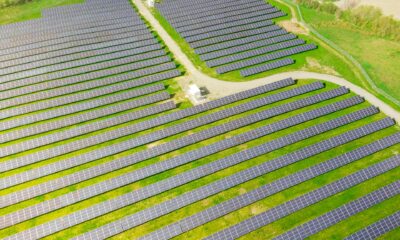Featured
ESG takes over the fixed income markets
Companies are thinking more about sustainability to attract all stakeholders. Sustainability reports increased from 20% of the S&P 500 in 2011 to 86% in 2018. Sustainable investments could displace industries or projects whose ESG credentials are considered less robust. The UN estimates that $3-5 trillion in investment is needed to achieve its sustainable development goals by 2030.

ESG investment seeks to incorporate non-financial elements that capture the environmental (E), social (S) and governance attributes (G) of a company. One of its paths addresses the effects on the global economic and investment landscape and are environmental or social in nature (climate change, education, obesity, etc.).
Green investment is another related category, explicitly focused on companies that improve the environment by employing or supporting “green” initiatives such as clean energy, resource conservation, etc. Bank of America analysts focus on the implications of ESG investing and how it applies to fixed income markets in their new report “ESG in fixed income – taking credit.”
Companies are thinking more about sustainability to attract all stakeholders (investors, issuers, rating firms…): sustainability reports increased from 20% of the S&P 500 in 2011 to 86% in 2018. The trend towards ESG is also part of the reorientation of the financial sector, driven by investor demand and policy changes to incorporate climate change and carbon transition issues into the investment process.
Thus, carbon-intensive industries are under the greatest pressure. These companies need to reformulate their business models, investment strategies and financing plans or face greater problems in raising money.
Read more about the importance of ESG and be the first to find out the most important finance news in the world with the Born2Invest mobile app.
ESG Investment Forecast
Sustainable investments could displace industries or projects whose ESG credentials are considered less robust. The UN estimates that $3-5 trillion in investment is needed to achieve its sustainable development goals by 2030. Much of this is expected to come from the private sector, which is where the fixed-income investor comes in. The United Nations Sustainable Development Goals (UN SDOs) comprise 17 interconnected goals that represent a blueprint for a more sustainable future. The goals include social issues such as non-poverty, zero hunger, education and gender equality. Some of the targets are more environmentally oriented, such as the climate.
Banks are also being encouraged to ‘green’ their lending practices to meet social goals and promote ODS and other global initiatives. The UN Principles for Responsible Banking (PRB) were launched in September 2019 with signatories representing 130 banks with $47 trillion in assets – that’s a third of the global banking sector. The network now includes over 160 banks. The Principles aim to align the banking industry with society to achieve Sustainable Development Goals and the targets identified in the Paris Climate Agreement. The Bank of England is launching climate stress tests by 2021. The European Banking Authority also considers metrics on future risk ESG issues.
Thus, in 2019, the European Union adopted a classification system that will provide a uniform approach to determining what is sustainable. From December 2021, the EU Taxonomy will apply to all EU markets. It will also affect the green bond market, which will have to comply with the taxonomy definitions
At its ECB meeting in late January, President Christine Lagarde said that as part of the review of the Bank’s strategy, she would consider options for being more intrusive and more active in relation to the Corporate Sector Buying Program (CSPP) and its ability to forge a response to climate change. It is known that the ECB has been buying green bonds that meet its eligibility criteria, but there’s doubt that it will become an entirely green program.
The profitability of investing in fixed-income ESG
Morningstar and Standard & Poor’s data indicated that ESG bond indices have closely tracked the risk and return characteristics of non-EESG indices with similar characteristics. Other studies indicated that corporate issuers with higher ESG credit ratings can outperform lower-rated issuers of the same index in a recession, but their profitability drops at times of rising markets.
Green bonds have fallen less than their euro-denominated Single A counterparts in 2020. From the beginning of the year to April 24th, the green bond index fell by -0.08% compared to -3.3% for Single As and -4.9% for 5-10 year maturities in euros. Even more surprising is the longer term performance: since January 1st, 2017 green bonds have gained 11.0% compared to 3.0% for Euro Single As and 5.7% for Euro 5-10 year companies.
Investing in fixed income ESG is key to the future, as it helps avoid issuers that are vulnerable to rating downgrades and rollover risk, leading to better returns.
The issuance of Green Bonds
Green bonds and other ‘tagged’ bonds saw an estimated $323 billion issued in 2019, according to the Climate Bond Initiative. About 80% of green bond issuance is highly rated, although issuance by sub-investment grade corporations is expected to grow. Europe has overtaken the US in both emission and demand. Social bonds raise funds for projects linked to positive social outcomes.
Almost half of the green bonds come from issuers domiciled in France, the Netherlands and Spain. The key industries for issuance are utilities and banks, with real estate in third place. 60% of the green bond issues from Spain are public services (44% and 47% for the Netherlands and France, respectively). Europe has led the way in green bond issuance, which continues to expand. The market reached almost EUR 120 billion in Investment Grade at the end of March, slightly less than 5% of bonds of the same rating outstanding in Europe. Total green bond issuance has grown year on year since 2016, although 2020 has had a slower start.
The effects of ESG on credit ratings
Fitch Ratings, Moody’s Investor’s Service and Standard & Poor’s now report on ESG considerations in individual sectors and companies. To some extent, ESG has always been incorporated into the ratings, particularly governance, although there has been a greater effort to highlight social issues separately and in greater detail. Climate change is the most commonly cited ESG factor, although agencies continue to highlight corporate governance as the most important factor for credit risk.
To date, less than 5% of ratings have changed due to ESG considerations. Still, the rating agencies are making a more timely effort to break down E, S and G factors to analyze whether and how they impact credit risk. The sectors of greatest risk for a credit downgrade are materials (mining, especially thermal coal, chemicals and building materials) and utilities in particular. With an above-average risk, where the automotive industry and durable consumer goods and clothing stand out. Also energy and industrial companies and transport. With a manageable level that affects their qualification, the telecommunications companies stand out, as well as the tobacco companies for their low environmental impact. Finally, from the point of view of qualification, finance, health, information technology or real estate companies are the least affected.
Social factors are the broadest part of ESG, and include workforce health and safety, diversity policies and opportunities, employee training, human rights, privacy and data security, and community relations and programs. Social concerns make education, healthcare and pharmaceutical companies more vulnerable.
Governance affects all issuers in all industries; it is no coincidence that the best qualified companies also tend to have strong governance. Topics include board independence and diversity, shareholder rights, management compensation and business ethics. Beyond that, it also includes transparency of information, management credibility, compliance and reporting, and a clear organizational structure.
__
(Featured image by nattanan23 via Pixabay)
DISCLAIMER: This article was written by a third party contributor and does not reflect the opinion of Born2Invest, its management, staff or its associates. Please review our disclaimer for more information.
This article may include forward-looking statements. These forward-looking statements generally are identified by the words “believe,” “project,” “estimate,” “become,” “plan,” “will,” and similar expressions. These forward-looking statements involve known and unknown risks as well as uncertainties, including those discussed in the following cautionary statements and elsewhere in this article and on this site. Although the Company may believe that its expectations are based on reasonable assumptions, the actual results that the Company may achieve may differ materially from any forward-looking statements, which reflect the opinions of the management of the Company only as of the date hereof. Additionally, please make sure to read these important disclosures.
First published in RankiaPro, a third-party contributor translated and adapted the article from the original. In case of discrepancy, the original will prevail.
Although we made reasonable efforts to provide accurate translations, some parts may be incorrect. Born2Invest assumes no responsibility for errors, omissions or ambiguities in the translations provided on this website. Any person or entity relying on translated content does so at their own risk. Born2Invest is not responsible for losses caused by such reliance on the accuracy or reliability of translated information. If you wish to report an error or inaccuracy in the translation, we encourage you to contact us.

-

 Africa6 days ago
Africa6 days agoMorocco’s Wheat Dependency Persists Despite Improved Harvest
-

 Crypto2 weeks ago
Crypto2 weeks agoBrazil’s Crypto Boom Threatened by Surprise Tax Proposal
-

 Biotech13 hours ago
Biotech13 hours agoEcnoglutide Shows Promise as Next-Generation Obesity Treatment
-

 Markets1 week ago
Markets1 week agoCocoa Prices Drop Amid Speculative Selling and West African Supply Concerns
























